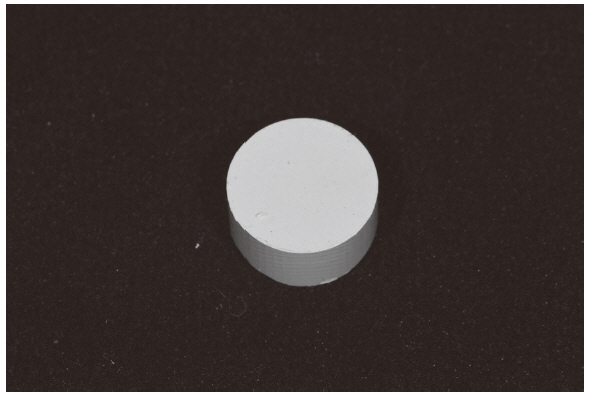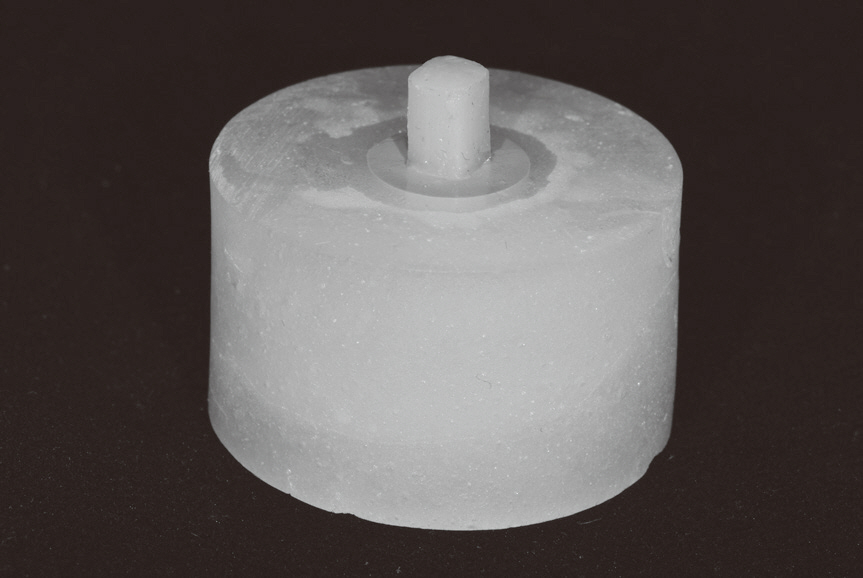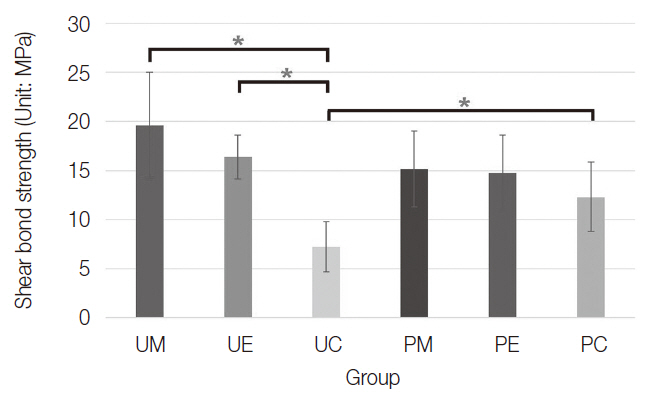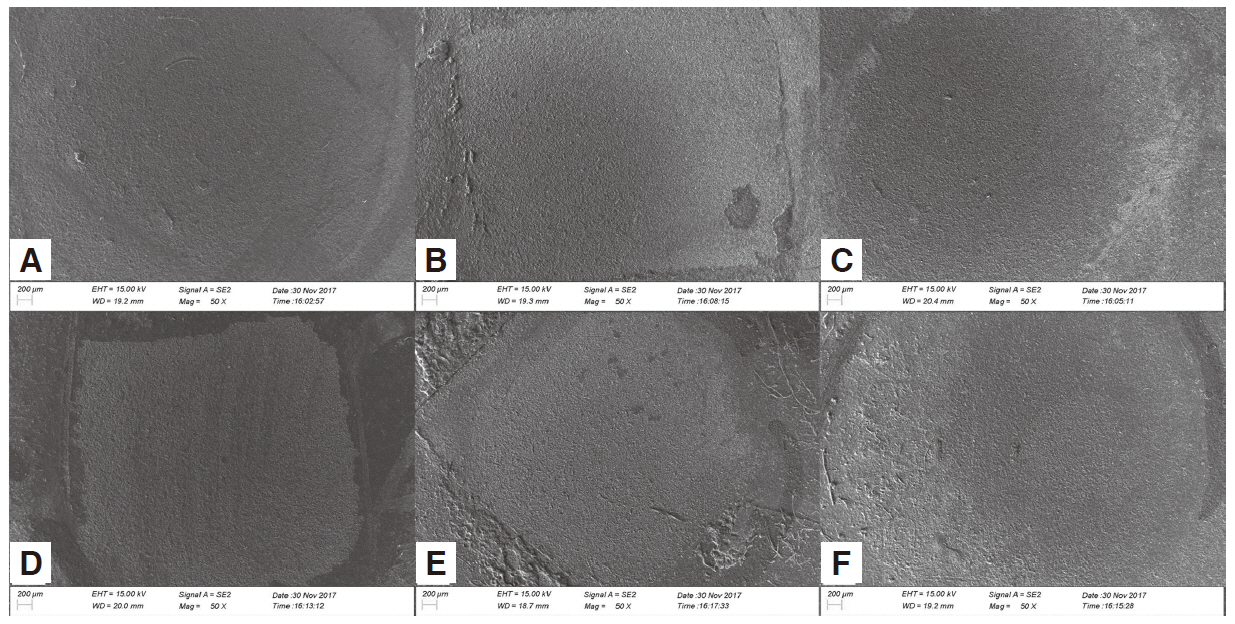J Dent Rehabil Appl Sci.
2020 Mar;36(1):1-11. 10.14368/jdras.2020.36.1.1.
Comparative study of surface modification on bond strength of polyetherketoneketone adhesively bonded to resins for temporary restoration
- Affiliations
-
- 1Department of Prosthodontics, College of Dentistry, Dankook University, Cheonan, Republic of Korea
- KMID: 2512130
- DOI: http://doi.org/10.14368/jdras.2020.36.1.1
Abstract
- Purpose
The purpose was to compare shear bond strength (SBS) of three types of resin for temporary restoration to polyetherketoneketone (PEKK) depending on surface modification.
Materials and Methods
Sixty disks made from PEKK were air-abraded with 110 μm alumina particles (Cobra, Renfert GmbH, Hilzinge, Germany) and thirty specimens were divided into two groups each:PEKK without Visio.link (Bredent, Senden, Germany)(U) and with Visio.link (P). Resins for temporary restoration (polymethylmethac-rylate; PMMA, polyethylmethacrylate; PEMA, bis-acryl composite resin) in the shape of a square with one side 3.2 mm were bonded to PEKK twenty respectively and classified into six groups (UM, UE, UC, PM, PE and PC). All specimens were stored in distilled water at 37°C for 24 hours. SBS of each group was measured at a crosshead speed of 2 mm/min in universal testing machine. SBS was compared using one-way ANOVA and a Tukey HSD test (P = 0.05).
Results
Group UM and group UE showed a significant difference in SBS with group UC (P < 0.05). Group PC showed a significant increase in SBS than group UC (P < 0.05).
Conclusion
It is recom-mended to apply Visio.link to PEKK for adhering bis-acrylic composite resin, but not for PMMA and PEMA in clinical practice.
Keyword
Figure
Reference
-
1. Kurtz SM, Devine JN. 2007; PEEK biomaterials in trauma, orthopedic, and spinal implants. Biomaterials. 28:4845–69. DOI: 10.1016/j.biomaterials.2007.07.013. PMID: 17686513. PMCID: PMC2040108.2. Fuhrmann G, Steiner M, Freitag-Wolf S, Kern M. 2014; Resin bonding to three types of polyaryletherketones (PAEKs)-durability and influence of surface conditioning. Dent Mater. 30:357–63. DOI: 10.1016/j.dental.2013.12.008. PMID: 24461250.3. Williams DF, McNamara A, Turner RM. 1987; Potential of polyetheretherketone (PEEK) and carbon-fibre-reinforced PEEK in medical applications. J Mater Sci Lett. 6:188–90. DOI: 10.1007/BF01728981.4. Stawarczyk B, Keul C, Beuer F, Roos M, Schmidlin PR. 2013; Tensile bond strength of veneering resins to PEEK: impact of different adhesives. Dent Mater J. 32:441–8. DOI: 10.4012/dmj.2013-011. PMID: 23719006.5. Liebermann A, Wimmer T, Schmidlin PR, Scherer H, Löffler P, Roos M, Stawarczyk B. 2016; Physicomechanical characterization of polyetheretherketone and current esthetic dental CAD/CAM polymers after aging in different storage media. J Prosthet Dent. 115:321–8. DOI: 10.1016/j.prosdent.2015.09.004. PMID: 26548869.6. Wimmer T, Huffmann AM, Eichberger M, Schmidlin PR, Stawarczyk B. 2016; Two-body wear rate of PEEK, CAD/CAM resin composite and PMMA: Effect of specimen geometries, antagonist materials and test set-up configuration. Dent Mater. 32:e127–36. DOI: 10.1016/j.dental.2016.03.005. PMID: 27033460.7. Geringer J, Tatkiewicz W, Rouchouse G. 2011; Wear behavior of PAEK, poly (aryl-ether-ketone), under physiological conditions, outlooks for performing these materials in the field of hip prosthesis. Wear. 271:2793–803. DOI: 10.1016/j.wear.2011.05.034.8. Bae SY, Park JY, Jeong ID, Kim HY, Kim JH, Kim WC. 2017; Three-dimensional analysis of marginal and internal fit of copings fabricated with polyetherketoneketone (PEKK) and zirconia. J Prosthodont Res. 61:106–12. DOI: 10.1016/j.jpor.2016.07.005. PMID: 27484816.9. Lee KS, Shin JH, Kim JE, Kim JH, Lee WC, Shin SW, Lee JY. 2017; Biomechanical evaluation of a tooth restored with high performance polymer PEKK post-core system: a 3D finite element analysis. Biomed Res Int. 2017:1373127. DOI: 10.1155/2017/7196847. PMID: 28386547. PMCID: PMC5366183.10. Han KH, Lee JY, Shin SW. 2016; Implant- and tooth-supported fixed prostheses using a high-performance polymer (Pekkton) framework. Int J Prosthodont. 29:451–4. DOI: 10.11607/ijp.4688. PMID: 27611747.11. Zoidis P, Papathanasiou I. 2016; Modified PEEK resin-bonded fixed dental prosthesis as an interim restoration after implant placement. J Prosthet Dent. 116:637–41. DOI: 10.1016/j.prosdent.2016.04.024. PMID: 27475921.12. Tannous F, Steiner M, Shahin R, Kern M. 2012; Retentive forces and fatigue resistance of thermoplastic resin clasps. Dent Mater. 28:273–8. DOI: 10.1016/j.dental.2011.10.016. PMID: 22130464.13. Burns DR, Beck DA, Nelson SK; Committee on Research in Fixed Prosthodontics of the Academy of Fixed Prosthodontics. 2003; A review of selected dental literature on contemporary provisional fixed prosthodontic treatment: report of the Committee on Research in Fixed Prosthodontics of the Academy of Fixed Prosthodontics. J Prosthet Dent. 90:474–97. DOI: 10.1016/S0022-3913(03)00259-2. PMID: 14586312.14. Vallittu PK. 1998; The effect of glass fiber reinforcement on the fracture resistance of a provisional fixed partial denture. J Prosthet Dent. 79:125–30. DOI: 10.1016/S0022-3913(98)70204-5. PMID: 9513095.15. Kim JY, Pfeiffer P, Niedermeier W. 2003; Effect of laboratory procedures and thermocycling on the shear bond strength of resin-metal bonding systems. J Prosthet Dent. 90:184–9. DOI: 10.1016/S0022-3913(03)00261-0. PMID: 12886212.16. Tetelman ED, Babbush CA. 2008; A new transitional abutment for immediate aesthetics and function. Implant Dent. 17:51–8. DOI: 10.1097/ID.0b013e318167648c. PMID: 18332758.17. Wittneben JG, Buser D, Belser UC, Brägger U. 2013; Peri-implant soft tissue conditioning with provisional restorations in the esthetic zone: the dynamic compression technique. Int J Periodontics Restorative Dent. 33:447–55. DOI: 10.11607/prd.1268. PMID: 23820704.18. Harder S, Kern M. 2010; Provisional treatment and soft tissue conditioning before and after implantation for single tooth replacement. Implantologie. 18:407–15.19. Hallmann L, Mehl A, Sereno N, Hämmerle C. 2012; The improvement of adhesive properties of PEEK through different pre-treatments. Appl Surf Sci. 258:7213–8. DOI: 10.1016/j.apsusc.2012.04.040.20. Keul C, Liebermann A, Schmidlin PR, Roos M, Sener B, Stawarczyk B. 2014; Influence of PEEK surface modification on surface properties and bond strength to veneering resin composites. J Adhes Dent. 16:383–92. DOI: 10.3290/j.jad.a32570. PMID: 25133270.21. Sproesser O, Schmidlin PR, Uhrenbacher J, Eichberger M, Roos M, Stawarczyk B. 2014; Work of adhesion between resin composite cements and PEEK as a function of etching duration with sulfuric acid and its correlation with bond strength values. Int J Adhes Adhes. 54:184–90. DOI: 10.1016/j.ijadhadh.2014.06.006.22. Sproesser O, Schmidlin PR, Uhrenbacher J, Roos M, Gernet W, Stawarczyk B. 2014; Effect of sulfuric acid etching of polyetheretherketone on the shear bond strength to resin cements. J Adhes Dent. 16:465–72. DOI: 10.3290/j.jad.a32806. PMID: 25264546.23. Stawarczyk B, Thrun H, Eichberger M, Roos M, Edelhoff D, Schweiger J, Schmidlin PR. 2015; Effect of different surface pretreatments and adhesives on the load-bearing capacity of veneered 3-unit PEEK FDPs. J Prosthet Dent. 114:666–73. DOI: 10.1016/j.prosdent.2015.06.006. PMID: 26344191.24. Stawarczyk B, Jordan P, Schmidlin PR, Roos M, Eichberger M, Gernet W, Keul C. 2014; PEEK surface treatment effects on tensile bond strength to veneering resins. J Prosthet Dent. 112:1278–88. DOI: 10.1016/j.prosdent.2014.05.014. PMID: 24969411.25. Stawarczyk B, Bähr N, Beuer F, Wimmer T, Eichberger M, Gernet W, Jahn D, Schmidlin PR. 2014; Influence of plasma pretreatment on shear bond strength of self-adhesive resin cements to polyetheretherketone. Clin Oral Investig. 18:163–170. DOI: 10.1007/s00784-013-0966-7. PMID: 23504226.26. Stawarczyk B, Keul C, Beuer F, Roos M, Schmidlin PR. 2013; Tensile bond strength of veneering resins to PEEK: impact of different adhesives. Dent Mater J. 32:441–8. DOI: 10.4012/dmj.2013-011. PMID: 23719006.27. Mondragon E, Söderholm KJ. 2001; Shear Strength of Dentin and Dentin Bonded Composites. J Adhes Dent. 3:227–36. PMID: 11803710.28. Oliveira ACC, Oshima HMS, Mota EG, Grossi ML. 2009; Influence of chisel width on shear bond strength of composite to enamel. Rev odonto Ciênc. 24:19–21.29. Sinhoreti MA, Consani S, De Goes MF, Sobrinho LC, Knowles JC. 2001; Influence of loading types on the shear strength of the dentin-resin interface bonding. J Mater Sci Mater Med. 12:39–44. DOI: 10.1023/A:1013848901553. PMID: 15348375.30. Stawarczyk B, Taufall S, Roos M, Schmidlin PR, Lümkemann N. 2018; Bonding of composite resins to PEEK: the influence of adhesive systems and air-abrasion parameters. Clin Oral Investig. 22:763–71. DOI: 10.1007/s00784-017-2151-x. PMID: 28647864.31. Lümkemann N, Strickstrock M, Eichberger M, Zylla IM, Stawarczyk B. 2018; Impact of air-abrasion pressure and adhesive systems on bonding parameters for polyetheretherketone dental restorations. Int J Adhes Adhes. 80:30–8. DOI: 10.1016/j.ijadhadh.2017.10.002.32. Kern M, Lehmann F. 2012; Influence of surface conditioning on bonding to polyetheretherketon (PEEK). Dent Mater. 28:1280–3. DOI: 10.1016/j.dental.2012.09.010. PMID: 23036863.33. Stawarczyk B, Silla M, Roos M, Eichberger M, Lümkemann N. 2017; Bonding Behaviour of Polyetherketoneketone to Methylmethacrylate- and Dimethacrylate-based Polymers. J Adhes Dent. 19:331–8. DOI: 10.3290/j.jad.a38894. PMID: 28849801.34. Silthampitag P, Chaijareenont P, Tattakorn K, Banjongprasert C, Takahashi H, Arksornnukit M. 2016; Effect of surface pretreatments on resin composite bonding to PEEK. Dent Mater J. 35:668–74. DOI: 10.4012/dmj.2015-349. PMID: 27477234.35. Schmidlin PR, Stawarczyk B, Wieland M, Attin T, Hämmerle CH, Fischer J. 2010; Effect of different surface pre-treatments and luting materials on shear bond strength to PEEK. Dent Mater. 26:553–9. DOI: 10.1016/j.dental.2010.02.003. PMID: 20206986.
- Full Text Links
- Actions
-
Cited
- CITED
-
- Close
- Share
- Similar articles
-
- Effect of surface treatment methods on the shear bond strength of auto-polymerized resin to thermoplastic denture base polymer
- Shear bond strength of a self-adhesive resin cement to resin-coated dentin
- The shear bond strength of two adhesives bonded to composite resin and glass ionomer cement restorations
- BOND STRENGTH OF VARIOUS RESINS TO DENTURE TEETH BY SURFACE TREATMENT
- A study of the tensile bond strength between Polyetherketoneketone (PEKK) and various veneered denture base resin








